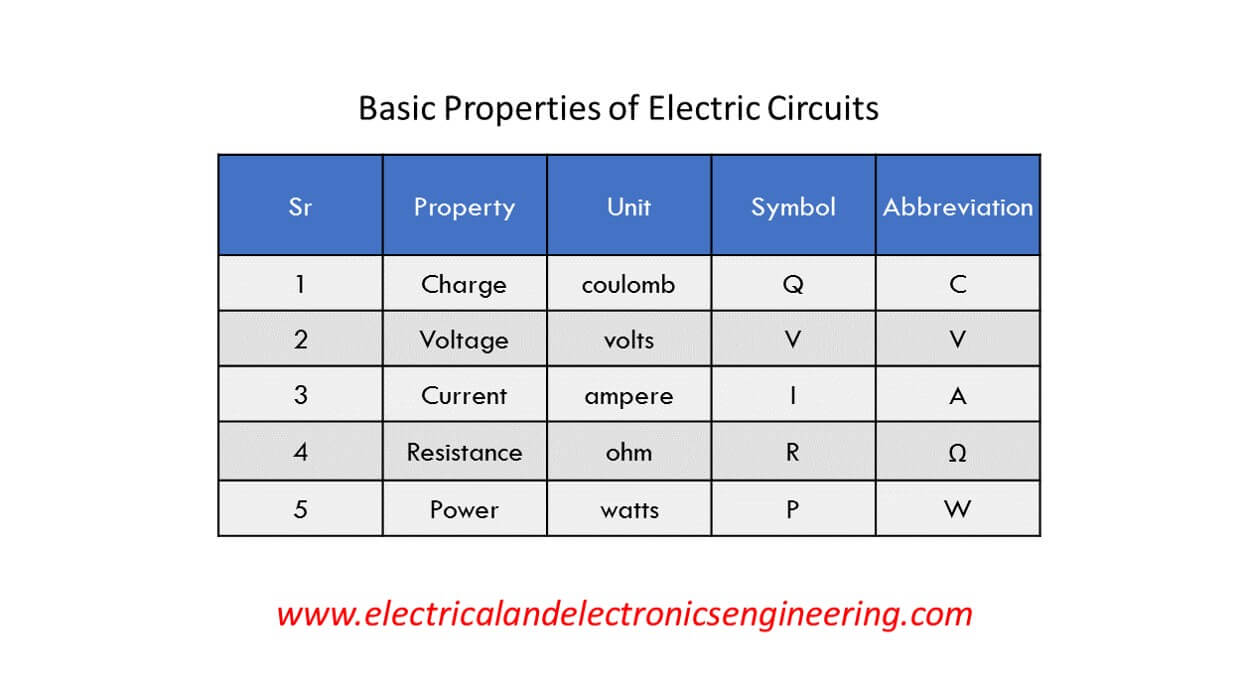An electric circuit is combination of two or more components that are connected together to obtain some output. Given below is the list of top 5 basic properties of electric circuits:
| Sr.no | Electrical Property | Unit | Symbol | Abbreviation |
|---|---|---|---|---|
| 1 | Charge | coulomb | Q | C |
| 2 | Voltage | volts | V | V |
| 3 | Current | ampere | I | A |
| 4 | Resistance | ohm | R | Ω |
| 5 | Power | watts | P | W |
Charge
Charge refers to the fundamental property of matter that causes it to experience electromagnetic interactions. It is denoted by the symbol “Q,” and its SI unit is the coulomb (C). Charge can exist in two forms: positive (+Q) and negative (-Q). The elementary unit of charge is the electron’s charge, which is approximately 1.6 x 10^-19 C. The mathematical formula relating charge, current, and time is Q = I * t, where Q represents charge, I represents current, and t represents time.
Voltage
Voltage, also known as electric potential difference, is a measure of the electric potential energy per unit charge. It is denoted by the symbol “V” and its SI unit is the volt (V). Voltage represents the driving force that pushes electric charges through a circuit. The mathematical formula relating voltage, current, and resistance is V = I * R, where V represents voltage, I represents current, and R represents resistance.
Current
Current refers to the flow of electric charge in a circuit. It is denoted by the symbol “I” and its SI unit is the ampere (A). Current can be either direct current (DC), which flows in a single direction, or alternating current (AC), which periodically changes direction. The mathematical formula relating current, voltage, and resistance is I = V / R, where I represents current, V represents voltage, and R represents resistance.
Resistance
Resistance is the property of a material or component to impede the flow of electric current. It is denoted by the symbol “R” and its SI unit is the ohm (Ω). Resistance determines how much voltage is required to produce a given amount of current in a circuit. The mathematical formula relating resistance, voltage, and current is R = V / I, where R represents resistance, V represents voltage, and I represents current.
Power
Power refers to the rate at which work is done or energy is transferred. In the context of electricity, it represents the rate at which electrical energy is consumed or produced. It is denoted by the symbol “P” and its SI unit is the watt (W). The mathematical formula relating power, voltage, and current is P = V * I, where P represents power, V represents voltage, and I represents current. Additionally, power can also be calculated using the formula P = I^2 * R or P = V^2 / R, where R represents resistance.
